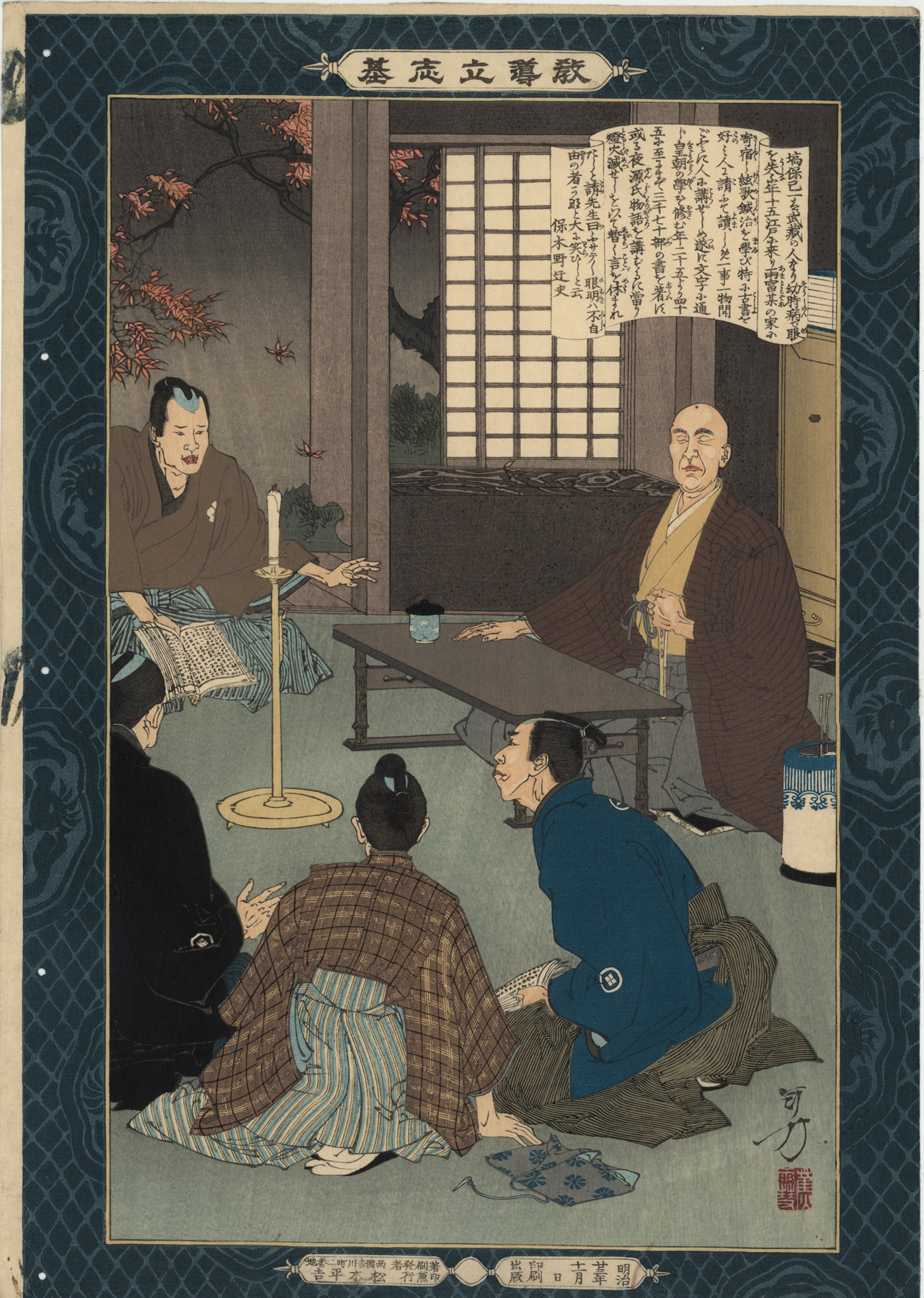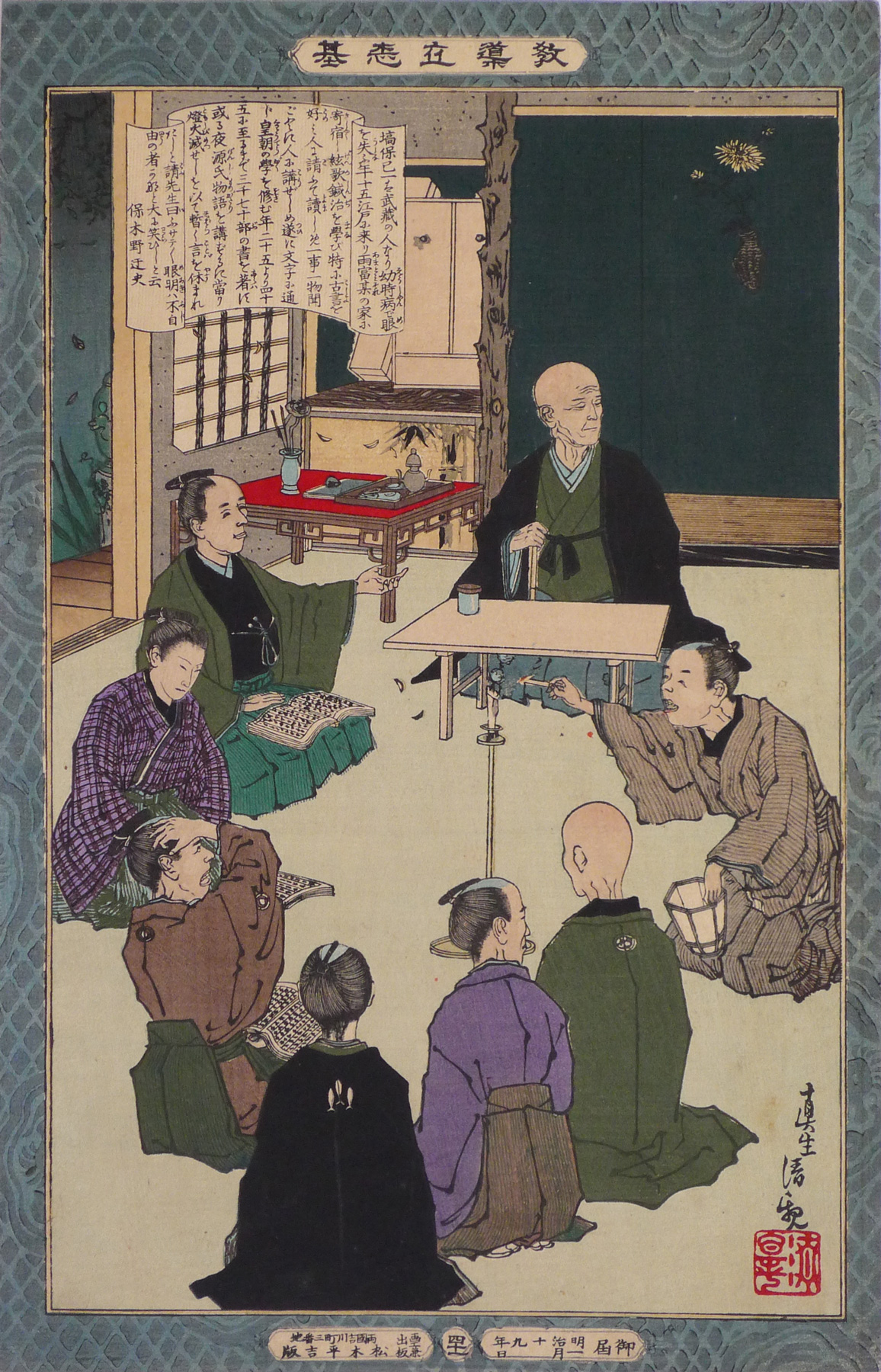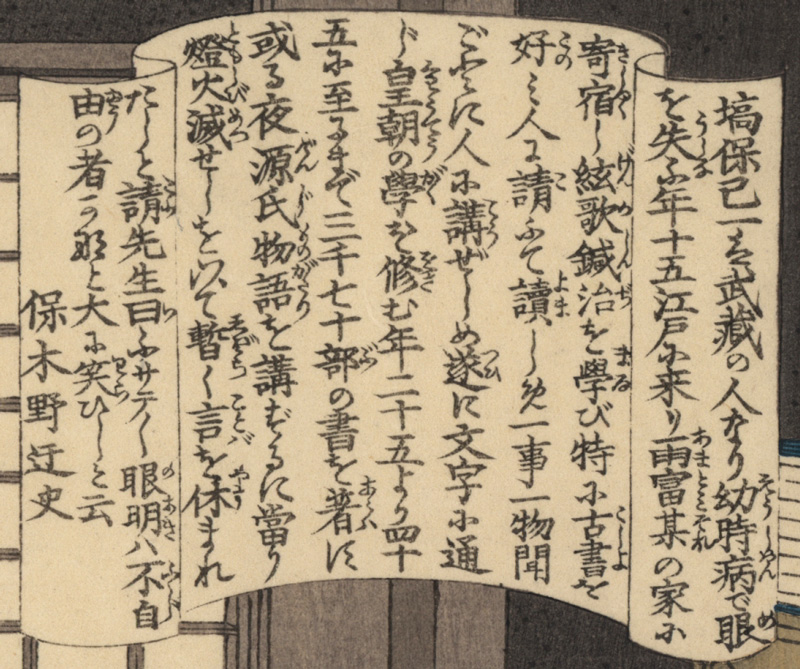About This Print
This unnumbered print1 was issued in November 1890 as a replacement for the Kobayashi Kiyochika (1847-1915) print of the same subject issued in January 1886. I assume that the blocks for the Kiyochika print were damaged or lost and that Toshikata was asked to provide a new design on the same subject. As with the Kiyochika print, Toshikata's print portrays a famous anecdote, see below, involving Hanawa Hokiichi (1746-1821), the blind Scholar of National Learning (kokugaku) and his students. The scroll-like cartouche on the prints contains exactly the same information.1 Numbering of the prints was haphazard during the production of the series. Print numbers were sometimes inadvertently omitted; some prints in the series were never assigned numbers and a few of the same numbers appear on different prints.
The Two Prints Side-by-side
Hanawa Hokiichi, 1886
Kobayashi Kiyochika
IHL Cat. #583
Hanawa Hokiichi, 1890
Mizuno Toshikata
IHL Cat. #1296
The Anecdote
Source: Famous People of Japan (Ancient and Modern), Edward S. Stephenson and W. Adano, Kelly & Walsh, Ltd., 1911, p. 154.Hanawa Hokiichi, the famous blind scholar and critic, was once reading with his students the well-known novel called Genji Monogatari. The lecture room was rather small, and was provided with only one lamp, by the light of which the students were just able to see their books. But while they were busily taking notes of their master's lecture, a puff of wind suddenly blew out the lamp and left them in darkness.
Hanawa, being quite unaware of this, calmly went on with his lecture; but the students, being of course unable to see to read or write, had to ask their master to stop for a few moments.
"Why, what is the matter?" inquired Hana-wa.
"It is the light, sir," they replied "The wind has blown out the light, and we can't see our books. Please wait a moment till we light the lamp again."
Hanawa smiled when he heard this, and replied, "That shows the inconvenience of having to depend on eyes; for when the light goes out, you suddenly become blind and helpless. But as for me, I'm fortunate in never having any trouble of this kind."
Hokiichi Hanawa
Source: Famous People of Japan (Ancient and Modern), Edward S. Stephenson and W. Adano, Kelly & Walsh, Ltd., 1911, p. 154.The story of Hanawa Hokiichi, the famous blind scholar who died in 1821, is probably without parallel in the literary history of the world. He was born in the province of Musashi, and became blind when only seven years old. He was sent to Yedo where he tried to learn music and also the art of shampooing, which is practiced by blind men in Japan; but he failed in both. Meanwhile, however, his wonderful memory began to attract the attention of people, for he is said to have remembered everything that he heard. At last, by the help of friends, he was able to devote himself entirely to study, and finally became a very learned man.
Availing himself of his marvelous memory, he set about the task of collecting miscellaneous old documents, and systematized them into well-arranged book form. This book was called the Gunsho Buijuand consisted of no fewer than 2,820 volumes, — the largest book ever published in Japan. It was reprinted during the Meiji era, and is still considered one of the most useful reference books, especially for historians.
He also found time to establish a school called the Wagakusho where he taught the Japanese classics to many students, whose admiration for him as a profound scholar and critic was equaled only by their devotion to him as a man.
Transcription of Scroll
click on scroll detail for enlargement
Source: with thanks to Yajifun http://yajifun.tumblr.com/
教導立志基 塙保己一 水野年方 1890年11月
Transcription:
“塙保己一は武蔵の人なり 幼時病で眼を失ふ 年十五江戸に来り雨富某の家に寄宿し絃歌鍼治を學び特に古書を好ミ人に請ふて讀しめ一事一物聞ごとに人に講ぜしめ遂に文字に通じ皇朝の學を修む 年二十五より四十五に至るまで三千七十部の書を著す 或る夜源氏物語を講ずるに當り燈火滅せしを以て暫く言(ことバ)を休まれたしと請 先生曰ふ サテ/\眼明ハ不自由の者かな と大に笑ひしと云 保木野 迂史”
About The Series "Kyōdō risshi no motoi"
Notes:1. This series is variously translated as "Instructive Models of Lofty Ambition," "Foundations of Learning and Achievement," "Foundation of Instruction and Perseverance," "Self-Made Men Worthy of Emulation," "Paragons of Instruction and Success," "Moral of Success," "Examples of Self-Made Leaders," and "Instruction in the Fundamentals of Success." The title in Japanese is sometimes seen as "Kyōdō risshiki or "Kyōdō risshi no moto," in addition to the most commonly seen transliteration of "Kyōdō risshi no motoi".2. For a complete listing of all the prints in the series and additional information please see the article on this site titled Instructive Models of Lofty Ambition.
This series ran between October 1885 and November 1890 and featured a long list of heroes and heroines, from antiquity to contemporary times, who were regarded as standards of moral leadership and self-realization.
Source: Kiyochika Artist of Meiji Japan, Henry D. Smith II, Santa Barbara Museum of Art, 1988, p. 74-75; original research and as footnoted.
This series of 58 prints,1 plus a table of contents sheet (目録), were originally published between October 1885 and November 1890 by the Tokyo publisher Matsuki Heikichi 松木平吉.2 The table of contents sheet issued by the publisher states that "fifty prints make up the complete set (五十番揃)". Three prints not in the initial release were added over the five year publication period, as were five redesigns of original prints, eventually increasing the total print count to 58. The seven artists contributing prints were Kobayashi Kiyochika (1847-1915) [20 prints], Mizuno Toshikata (1866-1908) [16 prints], Inoue Tankei (Yasuji) (1864-1889) [13 prints], Taiso (Tsukioka) Yoshitoshi (1839-1892) [5 prints], Yōshū Chikanobu (1838-1912) [2 prints], Toyohara Kunichika (1835–1900) [1 print], and Hachisuka (Utagawa) Kuniaki II (1835-1888) [1 print]. All the artists, with the exception of Yōshū Chikanobu, are listed in the top scroll of the table of contents sheet. Various colors (including blue, blue/green, and tan/brown) were used for the decorative border, and in 1902 the series was re-issued by Matsuki without borders.
Brief texts contained within a scroll-like cartouche appearing on each print provide historical details. The scroll composer's name is given at the end of the scroll text. The “lofty ambition” of the title is a Confucian concept, originally from Mencius, meaning “righteous determination that would inspire others.” The market for the series probably included former samurai, ambitious youth, and conservative intellectuals.
"[W]hen it was completed in 1890 the publisher was singled out for special recognition by the government for having sponsored such noble subject matter."3
This series ran between October 1885 and November 1890 and featured a long list of heroes and heroines, from antiquity to contemporary times, who were regarded as standards of moral leadership and self-realization.
Source: Kiyochika Artist of Meiji Japan, Henry D. Smith II, Santa Barbara Museum of Art, 1988, p. 74-75; original research and as footnoted.
This series of 58 prints,1 plus a table of contents sheet (目録), were originally published between October 1885 and November 1890 by the Tokyo publisher Matsuki Heikichi 松木平吉.2 The table of contents sheet issued by the publisher states that "fifty prints make up the complete set (五十番揃)". Three prints not in the initial release were added over the five year publication period, as were five redesigns of original prints, eventually increasing the total print count to 58. The seven artists contributing prints were Kobayashi Kiyochika (1847-1915) [20 prints], Mizuno Toshikata (1866-1908) [16 prints], Inoue Tankei (Yasuji) (1864-1889) [13 prints], Taiso (Tsukioka) Yoshitoshi (1839-1892) [5 prints], Yōshū Chikanobu (1838-1912) [2 prints], Toyohara Kunichika (1835–1900) [1 print], and Hachisuka (Utagawa) Kuniaki II (1835-1888) [1 print]. All the artists, with the exception of Yōshū Chikanobu, are listed in the top scroll of the table of contents sheet. Various colors (including blue, blue/green, and tan/brown) were used for the decorative border, and in 1902 the series was re-issued by Matsuki without borders.
This series of 58 prints,1 plus a table of contents sheet (目録), were originally published between October 1885 and November 1890 by the Tokyo publisher Matsuki Heikichi 松木平吉.2 The table of contents sheet issued by the publisher states that "fifty prints make up the complete set (五十番揃)". Three prints not in the initial release were added over the five year publication period, as were five redesigns of original prints, eventually increasing the total print count to 58. The seven artists contributing prints were Kobayashi Kiyochika (1847-1915) [20 prints], Mizuno Toshikata (1866-1908) [16 prints], Inoue Tankei (Yasuji) (1864-1889) [13 prints], Taiso (Tsukioka) Yoshitoshi (1839-1892) [5 prints], Yōshū Chikanobu (1838-1912) [2 prints], Toyohara Kunichika (1835–1900) [1 print], and Hachisuka (Utagawa) Kuniaki II (1835-1888) [1 print]. All the artists, with the exception of Yōshū Chikanobu, are listed in the top scroll of the table of contents sheet. Various colors (including blue, blue/green, and tan/brown) were used for the decorative border, and in 1902 the series was re-issued by Matsuki without borders.
Brief texts contained within a scroll-like cartouche appearing on each print provide historical details. The scroll composer's name is given at the end of the scroll text. The “lofty ambition” of the title is a Confucian concept, originally from Mencius, meaning “righteous determination that would inspire others.” The market for the series probably included former samurai, ambitious youth, and conservative intellectuals.
"[W]hen it was completed in 1890 the publisher was singled out for special recognition by the government for having sponsored such noble subject matter."3
1 The Tokyo Metropolitan Library online collection shows 50 prints and a Table of Contents sheet. The Table of Contents lists the titles of 50 prints. Smith in Kiyochika Artist of Meiji Japan identified 52 prints. I have identified 58 prints from this series including five prints (Ikina, Michizane Sugiwara, Kesa Gozen, Soga Brothers and Hokiichi Hanawa) that were re-designed and re-printed, likely due to damaged or lost blocks.
2 Robert Schaap notes in Appendix II, p. 166 of Yoshitoshi, Masterpieces from the Ed Freis Collection, Chris Uhlenbeck and Amy Reigle Newland, Hotei Publishing, 2011 that the series originally appeared as newspaper supplements.
3 The World of the Meiji Print: Impressions of a New Civilization, Julia Meech-Pekarik, Weatherhill, 1986, p. 122.
1 The Tokyo Metropolitan Library online collection shows 50 prints and a Table of Contents sheet. The Table of Contents lists the titles of 50 prints. Smith in Kiyochika Artist of Meiji Japan identified 52 prints. I have identified 58 prints from this series including five prints (Ikina, Michizane Sugiwara, Kesa Gozen, Soga Brothers and Hokiichi Hanawa) that were re-designed and re-printed, likely due to damaged or lost blocks.
2 Robert Schaap notes in Appendix II, p. 166 of Yoshitoshi, Masterpieces from the Ed Freis Collection, Chris Uhlenbeck and Amy Reigle Newland, Hotei Publishing, 2011 that the series originally appeared as newspaper supplements.
3 The World of the Meiji Print: Impressions of a New Civilization, Julia Meech-Pekarik, Weatherhill, 1986, p. 122.
Print Details
| IHL Catalog | #1296 |
| Title or Description | Hanawa Hokiichi 塙保己一 |
| Series | “Instructive Models of Lofty Ambition” (Kyodo risshiki 教導立志基) [note: series title also listed as 'Kyodo Risshi no Moto', ‘Kyodo risshi no motoi’, ‘Kyōdō risshi ki’ and variously translated as “Moral of success” or “Foundations of learning and achievement” or “Self-made Men Worthy of Emulation”' or “Examples of Self-made Leaders” or "Paragons of instruction and success"] |
| Artist | Mizuno Toshikata (1866-1908) |
| Signature |  |
| Seal | 年方蕉雪 sealed Toshikata and Shōsetsu, as shown above |
| Publication Date | November 1990 明治 廿三年 十一月 |
| Publisher | Matsuki Heikichi (松木平吉) proprietor of Daikokuya Heikichi [Marks: seal not shown; pub. ref. 029] click on image to enlarge (from right to left) publishing and printing date: 明治廿三年十一月 日 印刷 出版 [Meiji 23 11th month, printing and publication] assigned number within series: number omitted publisher information: 著印刷兼発行者 両国吉川町二番地 松木平吉 [printer and publisher Ryōgoku Yoshikawachō 2-banchi Matsuki Heikichi] |
| Carver | |
| Impression | excellent |
| Colors | excellent |
| Condition | good - full size; not backed; minor soiling; 5 small binding holes left margin; staining in left margin |
| Genre | ukiyo-e; rishki-e; kyōiku nishiki-e |
| Miscellaneous | no editions of this print carry a print number; it was a replacement for the Kiyochika print of the same title which carried print number 41 and was in position 42 of the Table of Contents for the series. |
| Format | vertical oban |
| H x W Paper | 14 1/2 x 10 in. (36.8 x 25.4 cm) |
| H x W Image | 12 1/2 x 7 15/16 in. (31.8 x 20.2 cm) area inside brocade border |
| Literature | |
| Collections This Print | Tokyo Metropolitan Library 280-K030; Edo-Tokyo Museum 96200403 |




